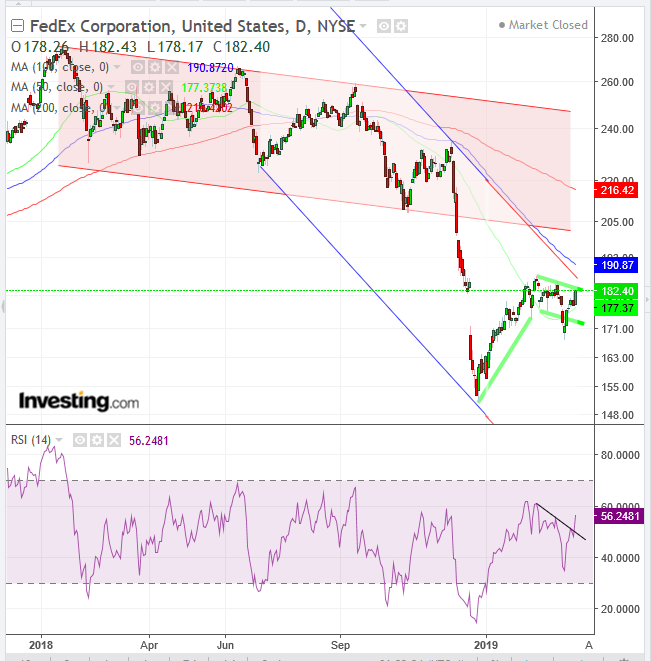Worldwide shipping and delivery service FedEx (NYSE:FDX) is scheduled to release Q3 earnings today, after market close. Analysts are pessimistic about today's report, citing competition, global economic headwinds and trade uncertainty, and consensus estimates see EPS of $3.14 on revenue of $17.62 billion, versus EPS of $4.03 and revenue of $17.8 billion in Q2.
Shares of the stock are up 13.08% year-to-date, slightly higher than the S&P 500 Index's 13.01% YTD. The stock closed 2.5% higher yesterday, at $182.40. However, some analysts aren't expecting today's earnings report to boost the stock, mainly on concerns that Amazon (NASDAQ:AMZN) is in the process of shifting from a customer into a competitor, although, according to Cowen analyst Helane Becker, the online retailing giant comprises 3% of FedEx's total revenue.
The Amazon threat comes against a background of slowing global growth and surging oil prices, both of which could create further serious headwinds for a company whose business is transportation. In addition, the looming trade war with China has obvious, direct implications for the delivery industry. Then again, Bank of America believes FedEx could turn its fortunes around by delaying half of its planned aircraft purchases from Boeing for two years and buoying the stock with buybacks of as much as $2.5 billion.
Both fundamentals and technicals are signaling a mixed picture for the company and the stock, and the negative views may well be proved wrong, at least in the near-term.The supply-demand balance shows a short-term uptrend, in conflict with medium and long-term downtrends.

The incredible rebound following the December rout paused on Feb. 13. Since then, the price has been ranging, with a downward bias in a falling flag formation, bullish following the previous rally. The pattern development at the top of a falling channel since June—resisted by the 100 DMA—magnifies the conflict between the short- and medium-term trend.
Beforehand, prices were ranging within a less steep descending channel since the Jan. 2018 record high, with the 200 DMA falling toward its bottom, above the top of the steeper, short-term falling channel.
The next major move could determine the short-term to medium-term trend. An upside breakout of the flag would include an upside breakout of the short-term descending channel since June and the 100 DMA. Such a move might recalibrate the trend to a more moderate downturn within the earlier descending channel, in effect since January. Then, bulls would have to prove their commitment, with an upside breakout of that channel.
Meanwhile, the first upside breakout would potentially trigger a cascade of orders—both via a short squeeze and triggered longs—to propel prices higher.
The RSI upside breakout suggests that is what will happen.
Trading Strategies Long Position Setup
Conservative traders should wait for an upside breakout of the upper boundary of the descending channel, as well as the flag, including the 100 DMA, below $191. Then, they would do well to wait for a return-move to confirm the reversal, when the price would bounce off the flag and channel-top, with at least a single long, green candle engulfing a red or small candle of either color.
Moderate traders would wait for the same upside breakout as described above. They can wait for the expected pullback as well but for a better entry, not necessarily for proof of the falling flag’s integrity.
Aggressive traders could enter a contrarian trade and go long now, counting on the flag’s completion, as indicated by the RSI, as a pessimistic view provides a bigger potential for a rise than a fall.
Trade Sample
- Entry: $182
- Stop-Loss: $178, below the lows of the last four trading sessions
- Risk: $4
- Target: $194
- Reward: $12
- Risk-Reward-Ratio: 1:3
